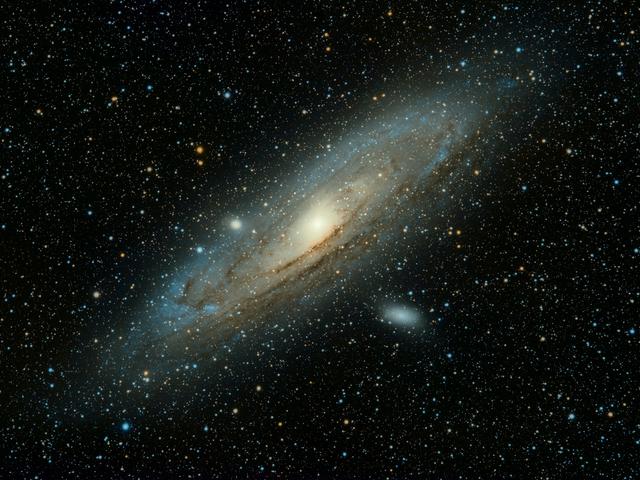When launched later this year on NASA’s Webb Space Telescope, the Airbus Near InfraRed Spectrograph (NIRSpec) – which is incorporated as a key instrument on the spacecraft – will provide deeper insights of the universe’s evolution.
NIRSpec was designed, developed, and integrated on the telescope by a team of more than 70 people at Airbus sites in Ottobrunn and Friedrichshafen, Germany, as well as Toulouse, France – with support from NASA and 17 European subcontractors.
It is one of four instruments on board the Webb Space Telescope (WST), which will succeed the Hubble Space Telescope as the next great space observatory. After launch, WST will embark on a month-long journey to its destination orbit around the second Lagrange point (L2), about 1.5 million kilometres away from Earth.
“I am very happy and excited to be still a part of the complete Webb team and to contribute to the greatest science story nowadays from the beginning to the end of commissioning. I am also very proud of the complete Airbus team working together as ONE team to make NIRSpec a success. Working with the complete Webb team all over the world (mainly with NASA) was and is the best experience I ever had.”
- Ralf Ehrenwinkler, Heaf of NIRSpec Programme
Deeper insights with NIRSpec
Known as the “super eye,” the NIRSpec instrument is a multi-object spectrograph capable of simultaneously measuring the near infrared spectrum of at least 100 objects – such as stars and galaxies – with various spectral resolutions down to 0.3 nanometres. The observations are performed over the wavelength range from 0.6 to 5.0 micrometres.
WST with the NIRSpec instrument will study the formation of the first stars and galaxies in our Universe, when it was only a few hundred million years old. NIRSpec will be able to capture the spectra of typically 60 to 200 galaxies at a time, allowing scientist to observe in exquisite details how they formed and evolved. Much closer to us, NIRSpec will also be able to study the atmosphere of exoplanets, these planets orbiting stars other than our Sun. It will, in particular, search for the signature of key molecules like water.
Due to NIRSpec’s excellent sensitivity, high resolution, and wide wavelength coverage, it is an ideal instrument to achieve a deeper insight of the evolution of the universe. It operates at -230 degrees Celsius and utilises a highly a-thermal concept (which prevents heat or changes in temperature), with the mirrors, mirror mounts, and optical bench base plate all manufactured out of Silicon Carbide Ceramic SiC 100®.
Commencing scientific operations
As the Webb Space Telescope will be observing the very faint infrared signals of very distant objects, this multi-billion-dollar space observatory needs to be shielded from any bright, hot sources – including the satellite itself. WST’s sunshield serves to separate the sensitive mirrors and instruments not only from the Sun and Earth/Moon, but from the spacecraft bus, as well.
Once the observatory has cooled down and stabilised at its frigid operating temperature in orbit, several months of alignments to its optics and calibrations of scientific instruments will occur. Scientific operations are expected to commence approximately six months after WST’s launch.
Airbus will support NIRSpec from liftoff to through the space telescope’s end-of-the commissioning phase. This includes monitoring its parameters 24/7 during the critical cool-down phase in space and initial functional testing when the NIRSpec instrument is turned on. The Airbus engineering team will continue to provide support from performance check-out and calibration through the WST’s commissioning.
Additional Facts
The James Webb Space Telescope (JWST) - carrying two Airbus instruments - will be launched from French Guiana on an Ariane 5 rocket. Here’s our top ten facts you need to know about the Hubble successor.
- Named after NASA administrator James E. Webb
The telescope is named after James E. Webb (1906–1992), NASA's second administrator. James Webb is best known for leading the Apollo exploration programmes that landed the first humans on the Moon. He also initiated a vigorous space science programme that was responsible for more than 75 launches during his tenure, including America's first interplanetary explorer spacecraft.
- The most powerful telescope ever
Jointly developed by NASA, the European Space Agency and the Canadian Space Agency, JWST is 100 times more powerful than Hubble, making it the largest, most powerful telescope ever launched into space.
- The Elephant in space
At 8m high, with a total mass of 6,200kg, it weighs almost as much as an African elephant.
- Peering back at the Big Bang
JWST will observe infrared light from space with unprecedented sensitivity, allowing it to peer back in time over 13.5 billion years to see the first galaxies formed after the Big Bang. It will push the frontiers of our knowledge, exploring how stars, planets and galaxies form, and studying our own Solar System as never before.
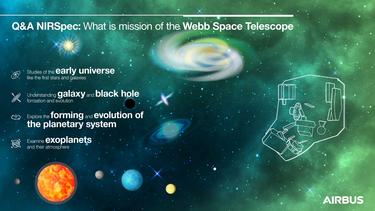
- Two Airbus instruments on board
JWST carries a suite of four instruments: NIRSpec (Near Infrared Spectrograph) and MIRI (Mid-Infrared Instrument) - both developed by Airbus, plus the NIRCam (Near-Infrared Camera), and FGS/NIRISS (Fine Guidance Sensors/Near-InfraRed Imager and Slitless Spectrograph), which are housed in the Integrated Science Instrument Module (ISIM).
- Tennis court-size protection shield
A giant, five layered shield protects the telescope and its instruments from the light and heat of the Sun. At 22 × 14 metres, it’s about the size of a tennis court. The shield will keep the telescope and its instruments permanently in the shade where they will cool down to -230ºC.
- Covered in a layer of gold
JWST’s primary mirror is 6.5 metres across (the Hubble one is 2.4 metres). Each of the telescope's mirrors are covered in a microscopically thin layer of gold, which optimises them for reflecting infrared light – the primary wavelength of light this telescope will observe.
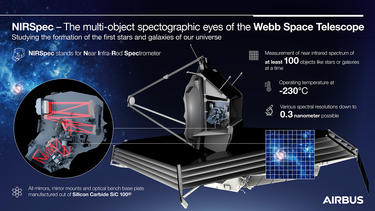
- Orbiting the sun
JWST will not orbit the Earth like Hubble does – it will actually orbit the Sun, 1.5 million kilometres away from the Earth. JWST will travel for about a month to reach its orbit.
- One kilowatt powerhouse
One kilowatt is about what it takes to heat up some leftovers in a microwave — or to power JWST. Thanks to its solar array, it will stay energy-efficient more than 1 million miles (1.5 million kilometres) from Earth. The “powerhouse” of the telescope, the array, will supply energy to all of the telescope’s scientific instruments and communication and propulsion systems. While JWST will only use 1 kilowatt of power, the solar array is capable of generating nearly double that amount to factor in the gradual wear and tear of a harsh space environment.
- $9.7 billion investment
JWST is expected to cost NASA $9.7 billion over 24 years. Of that amount, $8.8 billion was spent on spacecraft development between 2003 and 2021; $861 million is planned to support five years of operations.
Latest News
Continue Reading
Press Release Company
Airbus Defence and Space implements new organisation to shape division’s future…
The new organisation of Airbus Defence and Space will come into effect on 1 July 2025, as previously communicated.
Web Story Space
Why you should care about space weather

Web Story Space
Biomass, a satellite to look inside the world’s forests like never before
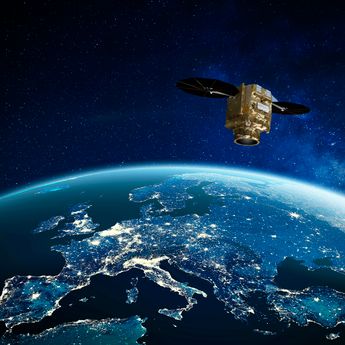
Web Story Innovation
Improving the world we live in with AI-powered products
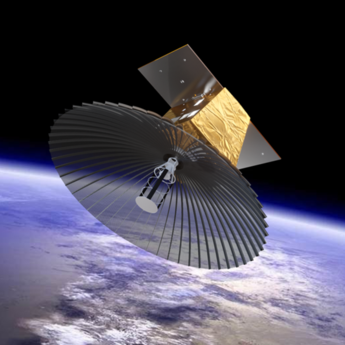
Press Release Space
Airbus awarded Oberon satellites contract by UK MOD
